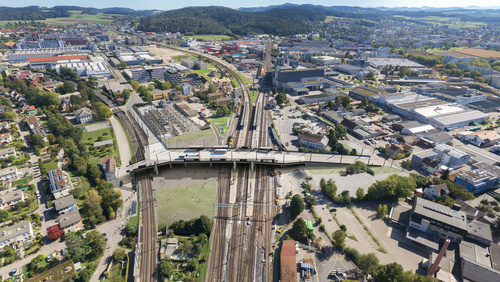Infrastructure Provision
Grüze crossing and railway access 23 Winterthur Grüze, City of Winterthur and SBB AG
City of Winterthur, Department of Construction, Civil Engineering & Swiss Federal Railways SBB AG
Winterthur Grüze railway station
2020 - 2026
The urban transport concept envisages an overall transport solution for the Neuhegi-Grüze area. This will contribute to good accessibility of the new urban centre (cantonal development area) for all modes of transport and users.
In the Grüze railway station area, a bridge is to be built over the tracks to connect Sulzerallee with St. Gallerstrasse and provide public transport access to the Neuhegi-Grüze area. The bridge also forms an important link in the designated high-capacity public transport corridor. As a central transport hub (bus-rail and rail-bus interchange), it is also intended to act as a catalyst for the development of the second urban centre in Winterthur.
The crossing will be equipped with bus stops, stairways and lifts to the railway platforms.
SBB AG - railway access 23 Winterthur Grüze and track renewal:
Winterthur Grüze station is currently not barrier-free and therefore does not meet the requirements of the Disability Discrimination Act (BehiG). As part of the "BZU23" programme, Winterthur Grüze station is to be made accessible to the disabled. In addition, tracks 6 and 7 will be renewed over a length of around 1.8 kilometres.
Due to their geographical location, the two projects mentioned above are closely interrelated and influence each other.
Added value
The "BZU23 WGR" project will make the entire Winterthur Grüze railway station, including all access points, barrier-free, while the "Grüze Crossing" project will realise the Neuhegi-Grüze area development and create a new transport hub for the region.
Individual services
- Integral construction phase planning: coordination and optimisation of the construction phases of both projects, with partial time overlap, with regard to railway operations and railway facilities in continuous coordination and cooperation with the project participants
- Study of variants
- Risk management
- Creation of a phase-appropriate construction schedule
- Creation of blocking patterns
- Creation of construction phase scheduling programmes
- Creation of construction phase sequence sketches
- Creation of interval programmes
 © City of Winterthur
© City of Winterthur